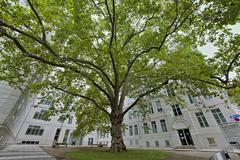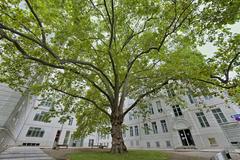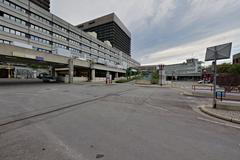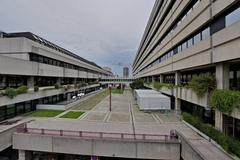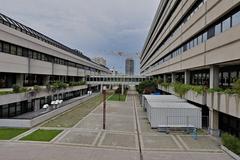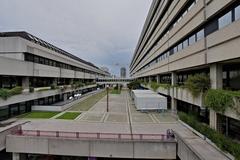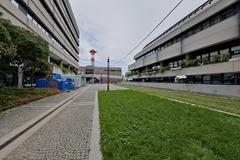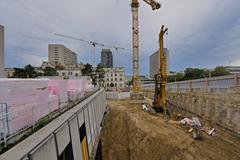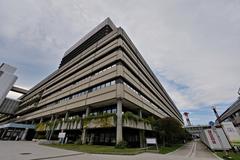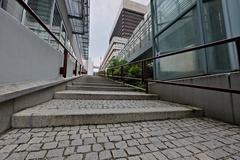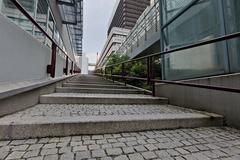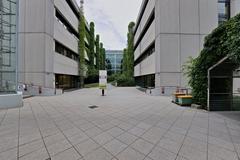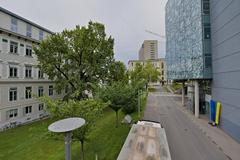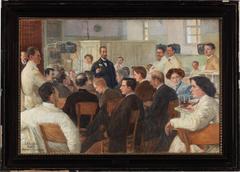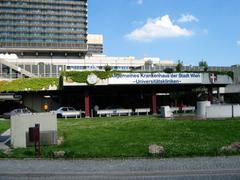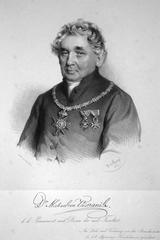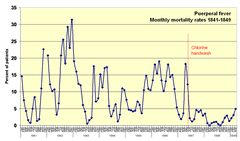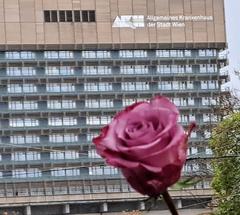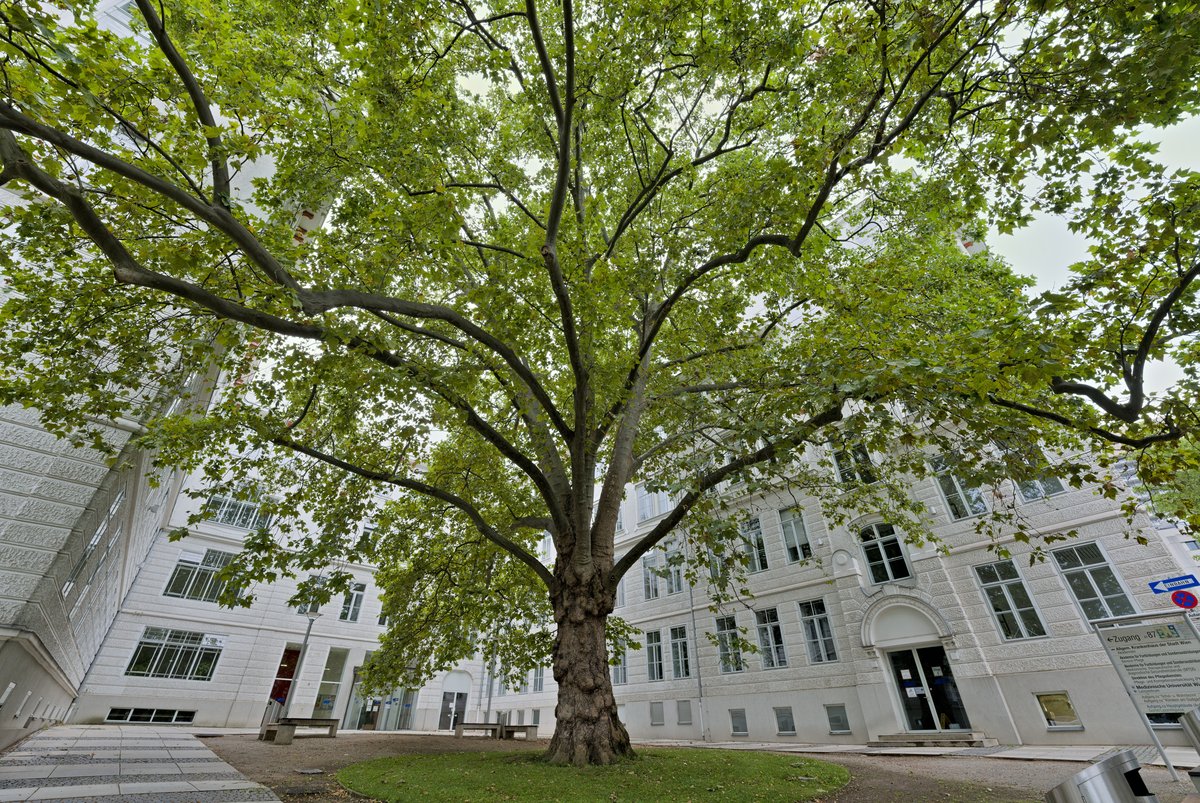
Vienna General Hospital (AKH Wien): Visiting Hours, Historical Significance, and Visitor Guide
Date: 14/06/2025
Introduction: Vienna General Hospital’s Legacy and Role
Nestled in Vienna’s vibrant 9th district, the Vienna General Hospital (Allgemeines Krankenhaus der Stadt Wien, or AKH Wien) is a monumental testament to centuries of medical innovation, architectural transformation, and cultural heritage. Established in 1693, AKH Wien began as a charitable institution for the sick and poor and evolved into one of Europe’s largest and most advanced medical centers. Closely affiliated with the Medical University of Vienna, it stands at the crossroads of historic medical breakthroughs and modern healthcare excellence.
Visitors to AKH Wien can experience not only a working hospital but also a living museum of medical history. Its grounds encompass the Altes AKH (Old General Hospital) courtyard, the Josephinum—a neoclassical jewel housing the Museum for Anatomical Wax Models—and other preserved sites that reveal the evolution of medicine in Vienna. These attractions, together with guided tours and educational programs, offer insights into the lives and achievements of luminaries like Ignaz Semmelweis and Karl Landsteiner.
For historians, travelers, and medical professionals alike, AKH Wien is more than a hospital: it is a cultural landmark and a symbol of Vienna’s enduring impact on global medicine. This guide details the hospital’s history, visiting hours, ticketing, accessibility, and nearby attractions, ensuring you have everything needed for a meaningful visit. For up-to-date information, consult the Medical University of Vienna history portal, Josephinum official site, and Vienna Tourist Information.
Table of Contents
- Early History (17th–18th Centuries)
- The Vienna Medical School and Clinical Breakthroughs
- The Josephinum: Architecture and Museum
- Modern Expansion and the New AKH
- Visiting Vienna General Hospital: Hours, Tickets, and Accessibility
- The Hospital’s Medical Innovations
- Preservation and Public Engagement
- FAQs: Visiting and Practical Information
- Key Milestones and Notable Figures
- Planning Your Visit: Tips and Nearby Attractions
- References
Early History (17th–18th Centuries)
Founded in 1693, Vienna General Hospital began as a charitable institution for Vienna’s poor and sick (Stratodesk, 2018). The original “Altes AKH” complex, built in the 18th century, was pioneering for its time, featuring a campus layout with multiple pavilions and courtyards to improve hygiene and patient outcomes. This innovative design influenced hospital architecture throughout Europe.
The hospital’s establishment was part of a broader Habsburg effort to modernize public health in the imperial capital. Its proximity to the University of Vienna fostered a synergy between clinical care and academic research, setting the stage for Vienna’s emergence as a medical education powerhouse (MedUni Vienna History).
The Vienna Medical School and Clinical Breakthroughs
In the 18th and 19th centuries, AKH Wien became the heart of the world-renowned Vienna Medical School. Under Empress Maria Theresa’s patronage, Gerard van Swieten reformed medical education and introduced systematic bedside teaching—a model still used today (MedUni Vienna History).
The hospital was also the birthplace of specialized clinics, establishing the world’s first dermatology, ophthalmology, and otolaryngology departments. This specialization marked a leap forward in medical science, cementing Vienna’s global influence in 19th-century medicine.
The Josephinum: Architecture and Museum
A highlight of the AKH campus is the Josephinum, built in 1785 under Emperor Joseph II and designed by Isidor Canevale. Originally the Imperial and Royal Academy of Military Surgery, the Josephinum is renowned for its harmonious classicist architecture and its collection of anatomical wax models—one of Europe’s largest (Josephinum Official Site).
Today, the Josephinum serves as a museum displaying over 650 years of medical teaching artifacts, instruments, and manuscripts. It provides an immersive journey through the evolution of medical science in Vienna.
Visitor Information:
- Opening Hours: Tuesday–Sunday, 10:00 AM–5:00 PM (closed Mondays and public holidays)
- Admission: Free (donations appreciated)
- Accessibility: Wheelchair access with ramps and elevators
- Guided Tours: Weekends and by appointment; booking recommended
Modern Expansion and the New AKH
By the 20th century, the original hospital could no longer meet modern healthcare demands. In 1957, plans began for a new hospital, with construction starting in 1964. Despite delays and cost overruns, the new complex was completed in the early 1990s, officially opening in 1994 (TourMyCountry).
Today, AKH Wien is among Europe’s largest hospitals, featuring:
- More than 1,900 beds
- Over 8,800 staff
- 27 university clinics and 311 outpatient clinics
- 51 operating rooms
- 1,792 consulting offices
It functions as the primary teaching hospital for the Medical University of Vienna and treats nearly two million patients annually (City of Vienna; Stratodesk, 2018).
Architecture: The modern AKH is known for its two “Bettentürme” (bed towers), a landmark of Austrian postwar architecture. The design emphasizes efficiency, patient flow, and integration with advanced technology, despite the project’s controversial cost overruns (TourMyCountry).
Visiting Vienna General Hospital: Hours, Tickets, and Accessibility
Public Access: While AKH Wien is primarily a medical facility, several historic and public areas are open to visitors:
- Altes AKH Courtyard: Now a lively commercial and entertainment area with shops and cafés.
- Josephinum Museum: Open to the public as described above.
Visiting Hours:
- Altes AKH: Open during standard daytime hours; hours vary by venue.
- Josephinum: Tuesday–Sunday, 10:00 AM–5:00 PM.
- Hospital Wards: Visitor access typically permitted 15:00–18:00, with last entry at 17:30. Check for updates, especially during health emergencies (Expatica).
Tickets: Entry to public areas is free. Special exhibitions or guided tours may require advance booking.
Accessibility: The complex is fully accessible, with ramps, elevators, and accessible facilities (Vienna Tourist Info).
Getting There: Located at Währinger Gürtel 18-20, 1090 Vienna.
- Subway: U6 (Michelbeuern-AKH station)
- Tram: Lines 5, 33, 42, 43
- Bus and Taxi: Available at main entrances
- Parking: On-site, but limited
The Hospital’s Medical Innovations
AKH Wien has been a crucible of medical breakthroughs. Close ties with the Medical University of Vienna have enabled advancements in surgery, internal medicine, and infectious disease research. Notably, the hospital’s archives include faculty files dating back to 1399, and its collections document the evolution of medicine from the Middle Ages to today (MedUni Vienna History).
Pioneers such as Ignaz Semmelweis (hand hygiene) and Karl Landsteiner (blood group classification) made landmark discoveries here, shaping modern healthcare worldwide.
Preservation and Public Engagement
The hospital’s heritage is preserved and shared through public exhibitions and tours, especially at the Josephinum (Josephinum Official Site). The Altes AKH, now home to restaurants, shops, and student life, retains its historical character (TourMyCountry). Visitors can also explore the vibrant Alsergrund district, with nearby attractions like the Freud Museum and Palais Liechtenstein.
FAQs: Visiting and Practical Information
Q: What are the main visiting hours for tourists?
A: Josephinum Museum: Tuesday–Sunday, 10:00–17:00. Altes AKH: daytime hours vary. Hospital wards: 15:00–18:00 (last entry 17:30), but check for current regulations.
Q: Is there an entry fee?
A: Public areas and the Josephinum are free. Donations are welcome.
Q: Are guided tours available?
A: Yes, especially at the Josephinum and for the Altes AKH area. Book in advance (Secret Vienna).
Q: Is the hospital accessible?
A: Yes, public areas are wheelchair accessible.
Q: How do I reach AKH Wien?
A: By subway (U6 to Michelbeuern-AKH), tram (5, 33, 42, 43), bus, or taxi.
Q: Can children visit?
A: Yes, but some clinical areas may have restrictions.
Q: Is photography allowed?
A: Not permitted in patient care areas. Allowed in public and museum spaces unless otherwise indicated.
Key Milestones and Notable Figures
- 1693: Hospital founded
- 1785: Josephinum constructed
- 19th Century: Vienna Medical School’s rise; pioneering clinics established
- 1957–1994: Modern AKH constructed and opened
- 2004: Medical University of Vienna gains independence (MedUni Vienna History)
Planning Your Visit: Tips and Nearby Attractions
- Combine Visits: Explore the Josephinum, Altes AKH, and nearby Alsergrund attractions like the Freud Museum.
- Plan Ahead: Check latest hours and events on official websites.
- Travel Smart: Use public transport for easy access.
- Accessibility: Contact ahead for special needs or group tours.
- Dining and Shopping: Enjoy the lively Altes AKH area’s cafés and shops.
References
- Stratodesk, 2018
- MedUni Vienna History
- Josephinum Official Site
- TourMyCountry
- City of Vienna
- Secret Vienna
- AKH Wien Official Website
- Vienna Tourist Info
- Expatica Austria
Final Summary and Visitor Tips
Vienna General Hospital (AKH Wien) invites visitors to experience a unique blend of history, innovation, and culture. Its preserved sites, like the Altes AKH and Josephinum, offer a window into centuries of medical progress. The hospital’s modern complex exemplifies ongoing leadership in healthcare and education. To make the most of your visit, plan ahead using official resources, explore the surrounding Alsergrund district, and respect the operating guidelines. For interactive maps and up-to-date visitor information, consider using the Audiala app.
For comprehensive and current details, refer to the Medical University of Vienna, Josephinum, and Vienna Tourist Information.
